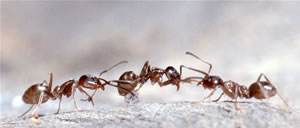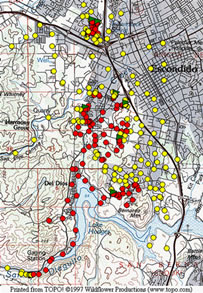Invasive Ants Territorial When Neighbors Are Not Kin
November 30, 2006
By Sherry Seethaler
A study led by UC San Diego biologists shows that invasive Argentine ants appear to use genetic differences to distinguish friend from foe, a finding that helps to explain why these ants form enormous colonies in California.

Argentine ants fighting. Photo Credit: Marc Dantzker
In the December issue of the journal Molecular Ecology, the biologists provide the first data on territorial interactions among Argentine ants in the field. In California, Argentine ants form expansive "supercolonies" containing millions of nests and stretching hundreds of miles. Researchers have disagreed on the reason for the lack of aggression between ants from different nests in the same colony.
"Some ecologists have hypothesized that environmental factors act to reduce aggression among Argentine ants in California," said David Holway, an assistant professor of biology at UCSD and senior author on the study. "However, we found that while ants from the same supercolony do not fight, clashes between ants from different supercolonies occur commonly along territorial borders."
The distance between nests did not play a role in ants' territorial behavior. Nor were there any obvious environmental clues to explain why ants would attack ants of the same species from one neighboring nest but not another. However, the researchers found a very close relationship between behavior and genetics. Ants that were genetically similar had peaceful relations. Ants that were genetically different attacked each other.
"Our results are strong evidence that lack of genetic diversity permits supercolonies to arise," said Melissa Thomas, who was a postdoctoral fellow working with Holway when she collected the data on territorial interactions. "Workers cannot differentiate between nestmates and non-nestmates if they all seem the same. So ants from different nests in the same colony do not fight

Map showing location of large supercolony (yellow dots), Lake Hodges supercolony (red dots) and observation sites (green triangles) north of San Diego. Map Credit: David Holway, UCSD
Five supercolonies of Argentine ants are known to occur in southern California. The largest supercolony extends about 600 miles throughout coastal California and abuts three of the four smaller colonies. At the territory borders, ants from different colonies engage in intense battles that result in the deaths of considerable numbers of workers. Thomas collected dead workers along small sections of the borders weekly. She estimated that border skirmishes around one of the smaller colonies, at Lake Hodges north of San Diego, killed at least 15 million workers over the six month study.
However, ants did not fight when placed with ants from a distant location in the same supercolony. Coauthors Christine Payne-Makris� and Andrew Suarez from the University of Illinois, Urbana and Neil Tsutsui from U.C. Irvine found that across the large geographical range of a supercolony ants were very genetically similar, but they were genetically distinct from ants in neighboring supercolonies. The researchers say that by keeping peace with their kin, the ants may be able to devote more resources to breeding rather than competing.
"Territory defense is expensive both in time and workers," explained Thomas, now a postdoctoral fellow at the University of Western Australia. "If nests invest this time and workforce into collecting resources and raising larvae instead of defending territories, then colonies should grow at a much faster rate."
In their native Argentina, aggressive interactions between colonies are much more common and colonies are significantly smaller. When Argentine ants were introduced to California 100 years ago, they spread widely because they did not encounter other colonies of Argentine ants. The biologists think that the distinct supercolonies in southern California arose from separate introductions of the ants, possibly in the soil of plants used in landscaping.
They hope that a better understanding of how the ants distinguish kin from non-kin, and the mechanisms that prevent gene flow between colonies, might lead to more effective ways to control the ants. That would be good news for anyone surrounded by the pervasive creatures.
"When people saw that the ants from different supercolonies were fighting with each other, they were glad to know that things were moving in the right direction," quipped Holway.
The study was supported by the U.S. Department of Agriculture, the California Department of Consumer Affairs Structural Pest Control Board.
Media Contact: Sherry Seethaler, (858) 534-4656
Comment: David Holway, (858) 822-5206
